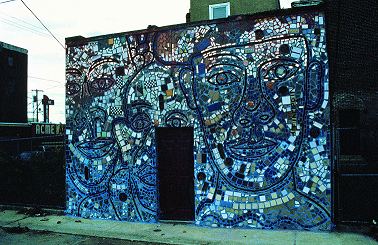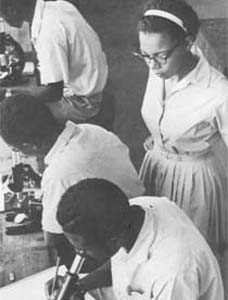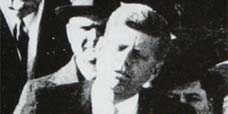
Peru RPCV Isaiah Zagar's Magic Garden Saves Itself from Bulldozers
Magic Garden Saves Itself from Bulldozers
Isaiah Zagar Mortgages House & Starts 501 C 3
by Mike DelVecchia
Isaiah Zagar. Photo, Allison Weiss.
The next time a tile falls off the hull of the space shuttle, pick it up, save it and slip it inside the donation box at 1022-24 South Street.
Artist Isaiah Zagar and his wife Julia need all the help they can get. "We've just taken out a mortgage on our house," said the sculptor.
The couple used its home at 826 South Street to underwrite the purchase of the lot containing the Philadelphia Magic Garden. "It was a long, drawn-out process finding a bank to get behind this," explained Garden administrator Allison Weiss, who added, "A few weeks ago, our bank, which had postponed our settlement four times, finally dropped out on us." Two days later, Weiss and Zagar convinced Hudson Bank of Philadelphia to loan Zagar $300,000. The deed of the property was filed in Zagar's name on November 8.
Last May, Zagar's telephone protests to Gaston Safar had not been enough to stalemate the eviction that had been announced by Safar's private equity firm, GS Partners Realty Trust of Boston. The firm had ordered the art to be removed by May 23. Zagar's initial negotiations with Safar were "awful."
"[Safar] threatened to bulldoze the site in minutes," said the artist, who claims to have phoned peacefully. "I was merely asking for more time and a possible lowering of his $300,000 price and Gaston goes and tells me he wants to bulldoze my art."
"Yes, I told [Isaiah] I was going to bulldoze his art and I meant every word of it because enough was enough," said Safar, who works as a hairdresser at Acote, the salon he owns on Boston's ritzy Newbury Street. "It was my property and Isaiah was squatting there free and thus illegally for years."
On Friday, May 14, Zagar's attorney Jamie Bischoff was at a meeting in New York City when her secretary, telephoning from Philadelphia, interrupted her gathering to relay the urgent messages about "frantic phone calls from Boston" that were coming from Safar to Bischoff's Market Street office. "Gaston gave me twenty four hours to ensure that Isaiah removed the art and threatened to have it removed if we didn't follow through," said Bischoff.
"I was going to come down there and punch him out," said Safar. "Zagar was making me angry because he wouldn't speak calmly and rationally with me. I mean, since when are you not allowed to run your property the way you like? Is this not America?"
Bischoff said she dropped what she was doing, fled New York and rushed to Philadelphia to prepare filing an injunction against GS Partners for the following Monday. The lawyer spent Saturday and Sunday with Zagar and Weiss, preparing the papers.
"I have never met Zagar, but I saw what he was passing off as art on my property," said Safar, who added, "Isaiah's work is not art. It's garbage. Zagar was like a guest whom you let come to dinner. And then he never wants to leave."
Bischoff was not intimidated. "By the time we threatened Gaston with filing, on the following Tuesday, he backed off. Gaston began to engage in fairly protracted negotiations afterwards."
"She kept sending me letters," said Safar. "They were going to sue me. They were going to have me subpoenaed. [Zagar] and his lawyer were not willing to admit that the artist's presence on the lot was illegal. Give me a break."
Detail of Waters Memorial Community Center, Kater Street entrance, 16' x 30'. photo, courtesy of Pew Arts
The lawyer began getting worth estimates of the property, which she decided were inconclusive (some estimates were inexplicably high, others were inexplicably low). Even though the lot had originally been purchased by Gaston Serge Realty Trust in 1988 for $130,000, "Gaston still wouldn't budge on the price."
While receiving sundry attention from the press, the sculptor placed a collection slot at the entrance of his studio, into which more than $5,000 was deposited as of Thanksgiving. A tablet was placed on a table so that passersby could reach through the rungs of the gate in order to sign the "Save the Garden," petition. Nearly 14,000 signatures have been received.
Bischoff not only handled negotiations with the real estate firm but oversaw the chartering of the Garden as a 501 C 3 corporation, titled, "Philadelphia's Magic Garden." The new group will possess the deed of the property and can bank the donations made to Zagar as soon as the tax exempt status becomes official. "We filed in August but it always takes a few months before the IRS gives such things the official stamp," said Weiss, who has been acting as treasurer and secretary for the fledgling group. Its new status has enabled the Garden to solicit donations, conduct fundraising campaigns and apply for organizational grants.
Zagar's recent location of what he calls, "a wealthy benefactor," has also improved the group's financial situation.
"There are a lot of reasons why we consider it a magic garden," said Zagar, who added he is "excited and lucky" to have found the donor, whose name he will not reveal. The benefactor has guaranteed to give the Garden $100,000 after two years have passed, provided that $200,000 can be raised by the Garden during that time. "You can bet we're going to do everything we can to raise that money," said Zagar.
Bischoff added, "The benefactor took over negotiations with Safar's lawyer and now has agreed to take care of the monthly mortgage payments so that the Zagars can keep their house, redeem the mortgage and have the time to show [the donor] they can secure the money."
The mortgage payments will be paid in addition to the $100,000 the donor has promised to give to the Garden after Isaiah raises $200,000."
One of the conditions is that the donor's identity must remain a secret. "He's just a public spirit who lives in the area," said Bischoff.
"It's out of my life now," said Safar, "I wish Zagar well and I know that many people believe in him. But after living amidst the Louvre and the artist Chateaus of southern France, where real artists keep real sculpture gardens, I can honestly say that Zagar keeps his new property looking like a pigsty." Safar moved to Boston 33 years ago, from Marseilles, France. He first saw the property on South Street in 1988 while visiting his brother Jean Pierre, who was then courting his future wife, Lori, who was then living in Philadelphia. Safar said, "I liked the lot and decided to buy it." Safar's brother Serge co-runs the Boston hair salon with Safar. The two are partners of several private real estate trusts.
Zagar, who has almost no personal income, must learn how to perform crack fundraising in a hurry. Safar's lawyer, Lou Orocofsky, speaking from his office on 830 South Street (two blocks east of the Garden), said, "We wish Isaiah and his Garden well in staying alive. We do understand the importance of preserving art in the city. But if you take a look at the situation he now finds himself in, you realize that Isaiah's presence on the property is still temporary."
After getting threatened by Safar, Zagar goaded the sympathy of First District Councilman Frank DiCicco whom Zagar claims promised to address City Council on his behalf. Next, local community groups were solicited regarding the possibility that the Garden could use a sympathetic group's not-for-profit status as an umbrella. David Hammond, Executive Director of South Street Headhouse, said that he was reluctant to provide grant counseling to the Garden. "Although they fall within our district, if we got them a grant, then Headhouse would be expected to perform the same service for everybody else on South Street." Hammond, who called the Garden, "a beautiful work of art," allowed Zagar free usage of Headhouse's nonprofit indicia to mail, "Save the Garden" notices.
Getting around; cruising Kenny Hill's folk art environment in Chauvin, Louisiana. photo, courtesy UCM Museum
Next, and executing his most effective brushstroke, the muralist sought the help of Philadelphia Volunteer Lawyers for the Arts (PVLA). Bischoff of Ballard, Spahr, Andrews and Ingersoll, was consigned by PVLA to provide pro bono assistance to Zagar.
The first exercise of the Garden's new tax exempt status will be a fundraiser that will be held at Beau Monde Restaurant on December 14 between 5pm and 8pm. The eatery is located at 624 South 6th Street. Tickets may be purchased for $50 in advance at Julia Zagar's Eyes Gallery at 402 South Street and at the restaurant's door. Beau Monde will be donating food and wine for the event.
In extending his beggar's cup, Zagar intends to incorporate the same energy he used to clean up the "bare canvas" lots of South Street and Broad Street, in ensuring that the lot, in which the Garden exists, never returns to the dilapidated, rat-infested, weedy condition in which he found it.
"When I hit South Street in 1969, it was mostly boarded up, derelict and hopeless," said Zagar. "The only reason I stayed here is because I realized that I could do my art in this place with its many nooks and crannies." Zip Code 19147 was two decades away from gentrification when Zagar was the self-proclaimed "South Street hippy." He would make camp in areas peripheral to the thoroughfare. "Usually alleyways are the only place where I can get work done," he said, adding, "Alleys are where people leave me alone." His work on the 700 block of South Clifton Street is remote enough to have allowed a massive, "self-motivated dream mural" to be composed without interruption. A circus scene, it depicts jugglers, strongmen and a twenty-foot-high elephant. "The largest elephant mosaic in the world," Zagar boasts, adding, "So big, she has a vent in her stomach." The deep entranceway of the Painted Bride at 230 Vine Street is also sufficiently off-the-beaten-path for the sculptor to have implemented his grout and tile technique comfortably, "where nobody was running over me," for eight years beginning in 1991.
The artwork of Zagar, who has erected 73 murals, has been destroyed before. Several years ago, two mosaics on the building housing Auntie Anne's Pretzels of Leithgow Street were mauled when construction workers popped an air conditioning unit through the walls of the building on whose north side Zagar had just finished an oeuvre. Holes were born for conduits, tools smashed the ceramics until only a portion of the smaller mural remained in tact. "The store owner had been kind enough to provide my artwork lighting, which is rare for me," said Zagar, who added, "But one day, when he was absent, the landlord came along and wouldn't wait for the owner to coordinate the conservation of my piece and went ahead and stuck an air conditioning system right through my mosaic."
It's not a hate for art, Zagar would have you know, but rather the behavior of people-- who aren't necessarily Philistines, but who could care more. The artist believes that DiCicco could have worked harder for him. "[DiCicco], although behaving positively toward our situation with the Garden, could have at least acknowledged me in front of City Council. He has, at his discretion, funding resources and has [State Senator Vincent J.] Fumo's ear into which he could argue that we deserve a grant. But Frank has never bothered to help us much."
Brian Abernathy, DiCicco's assistant, begged to differ. "We were never asked to acknowledge Isaiah in front of the Council. And it's not the councilman's style to argue something in front of Council or to a state senator that is strictly a district issue."
"I'm sorry that Isaiah feels that way," added DiCicco. "I personally met with them and had several telephone conversations. My Legislative Assistant Brian Abernathy also met with them several times to discuss ideas and options."
Abernathy explained that DiCicco went out of his way to provide optimistic quotes about the Garden to the press. Moreover, Abernathy claims, it was DiCicco's idea that Zagar approach Headhouse for help. "I think that Hammond didn't come through for Isaiah finally on a grant, because the Garden does not fall within the Headhouse district."
"No, it actually does fall within our district, which ends on the Garden's corner, at South 10th Street," said Hammond. "Again, we would have had to get a grant for everybody."
"But still, we are so sorry that we couldn't do more," said Abernathy.
DiCicco continued, "I know that Isaiah hoped the City could either purchase the property or contribute significant funds. Unfortunately, the City's fiscal crisis made those options impossible. I think everyone knows that during our last budget battle, City Council had to fight tooth and nail to save the little arts funding that we have. If I could have done more, I would have."
Carl Engelke, Director of Community Relations on Fumo's staff, said, "We made numerous suggestions to Isaiah about how he could have applied for grant money. But $300,000 is a lot of revenue to ask of the state."
DiCicco continues to speak positively about the situation. "I'm glad the Magic Garden has been saved from the wrecking ball. Isaiah's work, its unique beauty, adds character to South Street and the neighborhoods beyond."
Abernathy explained that last summer, DiCicco decided not to sponsor Zagar's request that the Garden become adopted by the Neighborhood Transformation Initiative (NTI). "The councilman decided that although the Garden is a beautiful thing, Isaiah's intention to keep it that way did not adequately fit in with NTI's mission of improving neighborhoods," said Abernathy.
"A lot the City is now doing to improve the neighborhoods," Zagar said, sarcastically. "Take a look at that cinderblock we've let sit at 230 South Street in place of the Knave of Hearts Restaurant." The edifice, built in 1734, was demolished last winter after owner "1970's Restaurant Renaissance" owner Ty Bailey sold it. In its place, work began on a structure intended to house a new restaurant with a Japanese and American cuisine. Construction ceased six months ago. A concrete frame now occupies the location.
"Frank [DiCicco] was very helpful, actually," said Bischoff. "I really think that Isaiah's expectations are for everybody to show his huge level enthusiasm for South Street, a place that was a ghetto when he arrived. [Isaiah] might be disappointed, for instance, that a city that doesn't have enough money, didn't end up buying the lot for him. But you have to understand that this artist, who was a huge figure in making sure that South Street became the national draw it is, is going to expect a lot from people who are supposed to be here to help him."
"Philadelphia is the center of the art world." photo, courtesy Pew Arts
Then there is the Percent for Art Program, to which Zagar had been presenting proposals since the seventies, "Until I became loathe to submit to them anymore." Zagar added, "I've done more public art in Philadelphia than most artists have done art, period. So, I don't need Percent for Art, which normally awards commissions to out-of-towners, to help me get venues."
Zagar's next "venue" will be the intersection of Berks Street and 20th Street. The Philadelphia Mural Arts Program (PMA) has commissioned Zagar to produce a porcelain, glass, ceramic and mirror transcription of the "pledge" of the Institute for Safe Families (ISF) by next spring. "This one, I'm fearing," said Zagar, "because we're racing toward winter and I always need a lot of help from the weather." Zagar, who will not reveal the amount of money PMA will pay him, said, "It's not much but I'm doing it for the love of it." Different from other public commissions, he will be provided scaffolding. "Usually, I've had to bring my own."
The words of the pledge (a writ recited by men with histories of family violence) contains 742 letters, each of which will be constructed from an equal number of focal point tiles. The mural will be 27 feet by 27 feet. In researching his creation in 1997 of a mosaic on the façade of the building occupied by Physicians for Social Responsibility (PSR)--- the organization whose spin-off group would later be ISF, Zagar had asked PSR's executive director for domestic violence statistics that could govern the tone of his piece. Zagar believes that he was a shoe-in for the new project because of his studied background in promoting the theme of both groups. The collaboration will be the first between Zagar and PMA.
"In the 35 years I've been on South Street, I've seen the art world grow exponentially through creativeness and activism," said Zagar. "I will say what I've been saying for many years, which is that Philadelphia is the center of the art world."
Zagar revisited the prospect of "shivering in the cold on a scaffolding," saying that he will collect himself in order to "undertake my usual jazz-like performance, transforming a wall with a disparate group of tiles that I pull together like a magician."
In further qualifying the term, "magic," to describe the Garden, Zagar is blithe. "Why do you bring this child to our gate every night?" Zagar said he asked a couple who had been visiting the garden with a newborn. The mother, he continued, explained that the infant, whose first word was "mosaic," would not go to sleep unless bedtime had been commenced with seeing the ceramic, mirror and glass wonderments bathed in purple and pink effulgence. Zagar explained that on another occasion, he was compelled to comfort a lone viewer who, after a long bout of her ogling, stood motionless at the gate, her eyes closed for several minutes. The woman, whom the artist said was from Korea, burst into tears, according to Zagar, who insisted that the viewer needed to be consoled in the arms of the creator whose beauty she had just witnessed. "This garden touches everybody deeply," Zagar said.
Zagar was born in 1939 at the vanished Philadelphia Osteopathic Hospital. After spending the first two days of his life in Philadelphia, he lived the next twenty-one years with his family in Brooklyn, New York. His first mural was done in crayon on the refrigerator, walls and ceiling of his parent's home on Haring Street in Marine Park, Brooklyn, when he was three. He received his B.F.A. in art from Pratt Institute in 1961. Spending the sixties "traveling the galaxy," he hewed a relationship between blue collar labor, folk and fine art, manifesting the life-lasting inspiration he experienced in 1959 at the New York Museum of Modern Art. There he witnessed the juxtaposing of pieces by architect Clarence Schmidt, and bricklayers Simon Rodia and Joseph Ferdinand Cheval with masterpieces by Pablo Picasso, Curt Schwitters, Antonio Gaudi and Jean Dubuffet. A visit to the home of architect Schmidt in Woodstock, New York, imprinted another example on the mind of the nascent mural. The moniker for Schmidt's house had been My Mirrored Hope, a name that would nominally foreshadow how the young muralist would later plant his stakes. Zagar would emulate Schmidt's modus operandi for home improvement in covering the exterior of his three-story South Street home in mosaic. The elderly Schmidt, who danced a jig after completing his manifesto (whereabouts unknown), knocked over a candle and burned the Woodstock house down. The mirrored wonderland (which had already been incensed several years earlier) was never rebuilt. At variance with Schmidt's disaster, Zagar said, "My intention is that the mosaics and the sculpture garden I have created will stay put, for as long as Philadelphia exists."
The Zagar's have two children, Ezekiel and Jeremiah. Ezekiel, who lives in Manhattan, is a musician. Jeremiah, who lives in the Dunbo area of Brooklyn, is a filmmaker.
A two-hour tour of the Magic Garden costs $35.00 per person. Reservations may be made at (215) 327-9911 or email info@isaiahzagar.com. A tax deductible donation can be mailed to Philadelphia's Magic Garden, 1003 Kater Street, Philadelphia, PA, 19147. Additional information may be obtained at www.isaiahzagar.com.











